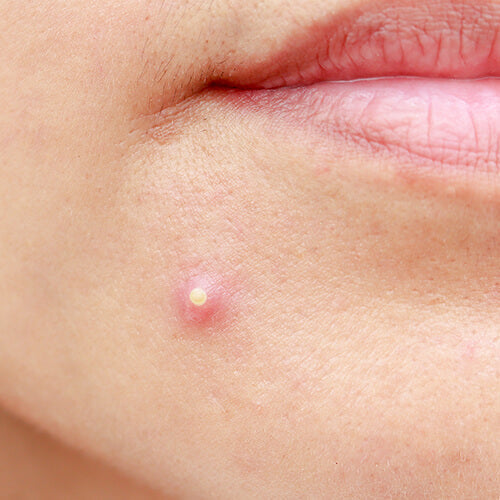Real skin problems. Real humidity. Real care.
Monsoon doesn't just shift the weather, it shifts your skin. From deeper dehydration to unexpected fungal breakouts, this is the season where skin misbehaves in ways most people don’t expect.
Here’s what really goes wrong and how to quietly fix it.
1. Monsoon Mold: Fungal Acne You Think Is Pimples

High humidity doesn’t just make your skin oily, it creates the perfect environment for fungal acne (Malassezia folliculitis). These look like small, itchy red bumps - usually on the forehead, cheeks, or upper back and don’t respond to salicylic acid or benzoyl peroxide.
Fix it:
- Use light, breathable products that support your skin barrier.
- Avoid heavy oils, fatty alcohols, and excessive layering, gentle cleansing and simple routine work best.
- For cleansing, try a gentle face wash like the Evermore Cactus Face Wash, which helps keep skin clean without drying it out.
2. Sweat + Pollution = Invisible Dirt Film

During monsoon, pollution doesn’t disappear it mixes with moisture and sits longer on your skin. This invisible grime is a key culprit behind sudden breakouts or dullness, especially when you're indoors all day with fans and moisture swirling around.
Fix it:
-
A gentle face wash that doesn’t strip but still deeply cleans.
- Over-cleansing is just as damaging as doing nothing, so stay consistent, not aggressive.
- Following up with a hydrating toner, such as Evermore’s Hydrating Toner, helps restore your skin’s balance.
3. Puffier, Duller Under-Eyes

Rainy weather disrupts routines with less sunlight and heavier air. High humidity makes the body retain water and salt, causing puffiness around the eyes. Staying indoors and reduced movement slow circulation, dulling the skin. Plus, more screen time adds eye strain, making under-eyes look tired.
Fix it:
- Use something light and soothing around your eyes to hydrate and reduce puffiness without irritation.
- A gentle option like Evermore’s Under Eye Cream refreshes tired eyes without irritation.
4. Breakouts Around the Hairline? It’s Not Random

Monsoon brings more frizz and with it, more conditioners, leave-ins, and masks. These products often slide down to your forehead or temples while it rains or even during a shower. At the same time, your scalp produces more oil in humid weather.
The result? A mix of sweat, scalp oil, and product residue clogs pores along your hairline leading to those tiny, stubborn bumps near the scalp.
Fix it:
- Cleanse around your hairline thoroughly, and keep both your scalp and forehead free of buildup.
- Avoid overlapping your skincare and haircare products in this area to prevent clogged pores.
5. Rainwater is Not Pure
Urban rain carries acidic pollutants that disrupt skin pH and barrier health. Sensitive skin often flares up after rain exposure not from water, but from what’s in it.
Fix it:
Rinse with clean water after getting wet. Use a balancing toner or calming mist to restore your skin’s balance.
6. Sensitivity & Sudden Skin Reactions
High humidity and pollution during monsoon weaken your skin’s protective barrier, making it more sensitive. This can cause sudden redness, irritation, or tiny bumps often triggered by over-washing, hot showers, quick product changes, or touching your face with wet hands.
Fix it:
Keep your skincare gentle and consistent. Avoid over-washing and hot water. Don’t switch products too quickly, and always use clean, dry hands when touching your face.
7. Humidity Doesn’t Equal Hydration
Skin often sweats on the surface but stays dry inside. This leads to dehydration, patchiness, and dullness all while looking greasy. Especially in AC environments, the surface stays oily while the inner layers remain parched. This is when people over-cleanse, skip moisturizers, or turn to blotting products only worsening dehydration.
Fix it:
- Layer light, water-binding hydration just after cleansing. Try a lightweight option like Evermore’s Cactus Moisturiser for balanced hydration without heaviness.
- If your skin feels tight after washing and greasy an hour later, it’s a hydration imbalance, not just oiliness.
Final Thoughts: Simple Tips for Monsoon Skin Care
Monsoon skin troubles can feel confusing because the season brings a mix of challenges - humidity, pollution, and changes in routine all affecting your skin in different ways. To keep your skin healthy this season, here are some easy tips you can follow:
- Keep hands clean: Always use clean, dry hands to touch your face to avoid infections or irritation.
- Rinse off rainwater: Rainwater can have pollutants, so rinse your face with clean water after getting wet outside.
- Avoid over-washing: Washing your face too often can dry out your skin and make problems worse. Twice a day is enough.
- Cleanse carefully around hairline: Sweat and hair products can clog pores near your forehead—make sure to cleanse this area well.
- Keep it gentle: Use mild cleansers and avoid harsh scrubs or strong acne medicines that can irritate your skin.
- Don’t skip toner: A gentle, balancing toner helps keep your skin’s natural protective layer healthy and reduces irritation.
Following these simple steps will help your skin stay comfortable, fresh, and less prone to problems during the rainy season.








